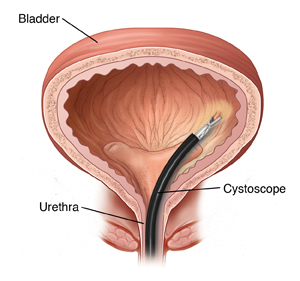Transurethral Resection of Bladder Tumor
This procedure may be called a transurethral resection of bladder tumor (TURBT) or transurethral resection (TUR). Tiny pieces of tissue, called samples, are taken from inside your bladder. This is called a bladder biopsy. The samples are then tested in a lab. The rest of the bladder is left in place.
This procedure is done to help find out if a person has bladder cancer. If the tumors are very small and haven't spread deep into the bladder wall, TURBT may be part of treatment.

Getting ready for the procedure
Follow the directions you were given to get ready for the procedure. Also:
-
Tell your healthcare provider about all medicines you take. This includes any over-the-counter medicines, herbs, vitamins, CBD, and other supplements. You may need to stop taking some or all of your medicines before TURBT.
-
Follow any directions you are given for not eating or drinking before the procedure. (If you've been told to take medicines, take them with a small sip of water.)
The day of the procedure
TURBT is done in a hospital or outpatient surgery center. The procedure takes about 30 to 45 minutes. You’ll likely go home the same day.
Before the procedure begins
What to expect before the procedure:
-
A small tube called an IV (intravenous) line is put into a vein in your arm or hand. Fluids and medicines (such as antibiotics) might be given to you through your IV.
-
To keep you from feeling pain during the procedure, you'll be given medicine called anesthesia. You may be given general anesthesia. This puts you into a deep sleep. If you get general anesthesia, you may have a breathing tube put in and will be on a breathing machine. Another choice is spinal anesthesia. This numbs your body only from the waist down. You will discuss your choices with your anesthesiologist.
During the procedure
What to expect during the procedure:
-
A special tool called a resectoscope (scope) is used. This is a thin, lighted rigid tube with a tiny lens on the end. It's used to see inside the bladder. The scope goes into your bladder through your urethra. The urethra is a thin tube in your body that passes pee from the bladder to the outside of your body.
-
The scope has a small, electrified wire loop at the end to remove (resect) the bladder tumors. It's used to take out small samples of abnormal and surrounding tissue from the bladder lining and the layers right under it. An electric current (cautery) is used to take out abnormal tissue and stop any bleeding.
-
When the procedure is over, the scope is removed. The bladder is drained.
-
A soft, thin tube (Foley catheter) may be put in your bladder. This is to drain pee while the bladder heals.
After the procedure
You’ll be taken to the postanesthesia care unit (PACU) to be watched as you awake from the anesthesia. If a breathing tube was used, it is removed at the end of the procedure. Your throat might be sore at first for a short time. You might be given medicines to control pain and help prevent infection.
The Foley catheter in your bladder will be attached to a bag to collect your pee. You might go home with this catheter. If so, you'll be taught how to take care of it and empty the bag.
After a few hours, you’ll be able to go home. Have an adult family member or friend ready to drive you.
Recovering at home
Once you’re home, be as active as you comfortably can. Get up and walk around. But don't exercise or do any heavy activities until you feel better. You can likely return to your normal routine in 1 to 2 days. If you go home with a catheter, care for it as directed. Also be sure to follow any special instructions from your provider.
When to call your healthcare provider
Call your provider right away if you have any of the following:
-
A fever of 100.4° F ( 38°C) or higher, or as directed by your healthcare provider
-
Pain that’s not controlled with medicine
-
Trouble peeing or being unable to pee after the procedure or after the Foley catheter is removed
-
Bloody pee for more than 48 hours or bloody pee that is increasing
-
Blood clots in the pee
Call 911
Call 911 if you have:
-
Chest pain
-
Trouble breathing
Follow-up
You’ll have a follow-up visit with your healthcare provider in about 7 days. During this visit, your provider will talk with you about the results of your biopsy. You may have the urinary catheter removed if you went home with it. You and your provider will also discuss any treatments that might be needed.
Risks and possible complications
Risks of this procedure include:
-
Pain or burning feeling when peeing for a few days after the procedure (this is normal)
-
Increasing blood in the pee
-
Infection
-
Damage to the bladder wall (may need a short-term catheter or more surgery to repair)
-
Narrowing of the urethra
-
Risks of anesthesia. You will discuss these with the anesthesiologist before the procedure.
Talk with your healthcare provider about what you can expect this procedure to be like. Be sure you understand what problems you should watch for and know how to get help anytime you have problems. This includes after office hours and on weekends and holidays.